The Zero RB Dynasty Startup Strategy
Most dynasty owners develop a plan of attack or a strategy while preparing for a startup draft. There are different strategies that can be implemented to build a championship team. Switching up your approach while drafting in different startup drafts can break up the monotony and provide a different perspective on how to build the perfect team. Not developing a plan going into a startup draft could become hazardous, causing the owner to make irrational draft selections while on the clock.
No matter what the format is, whether it’s redraft, dynasty or devy, fantasy football has encountered numerous different draft strategies. Currently, one of the new polarizing draft strategies in redraft leagues is Zero RB, the strategy advocates fading running backs until the later rounds due to the fragility of the position. With the NFL constantly changing and the dominance of the passing game gradually increasing, it makes a lot of sense to follow suit and model our dynasty strategies to reflect current trends of the NFL.
Is a Zero RB draft strategy applicable to dynasty? The common thread amongst dynasty owners is that most of them like to stock up on wide receivers during the early rounds of the draft because of the longevity of the position. Zero RB is very comparable to what most dynasty owners are already doing but the strategy takes stocking up on wide receivers to a new extreme. Instead of concentrating on receivers during the first few rounds of the draft while sprinkling in a few running backs, Zero RB encourages you to hone in on receivers until the player pool runs dry. This gives your roster depth with premium prospects at the wide receiver position, allowing you mine value at other positions later in the draft.
[am4show have=’g1;’ guest_error=’sub_message’ user_error=’sub_message’ ]
Roster Construction Is Key
The strategy emphasizes the value of roster construction by building a team around positions that are easier to predict from year to year and spending less capital on positions that are considered highly volatile. Roster sizes and limitations should be strongly considered while making your draft selections because it can play a major factor on the appropriate amount of depth a team should have. For example, if the league requires that a team must start three wide receivers and a flex then the goal would be to draft eight solid wide receivers, because you are more than likely going to start four receivers on a weekly basis and the added depth is necessary to cover bye weeks and injuries. Dynasty is a war of attrition due to the constant roster turnover from injuries and other unpredictable events and the teams with the most depth are more likely to make the playoffs, especially two or three years down the road when the other teams in the league start to lose some of their talent.
Quarterback
Not only are we fading running back late into the draft but we are also implementing the late-round quarterback strategy. We will have the ability to draft two or three marginal quarterbacks at a very cheap price, allowing us to bolster our roster at other positions during the draft. Matt Stafford finished 12th in the league with 25.74 fantasy points per game, which isn’t much of a drop off from Sam Bradford who finished the season ranked 30th in the league amongst quarterback with 20.4 fantasy points per game. Streaming two or three replacement level quarterbacks from week to week can provide QB1 level production if you play the right matchups.
Running Back
The premise of the strategy is to draft running back late to allocate assets at other positions. The running backs we want to target in the later round are situational pass catching backs and older running backs who are undervalued and are still receiving a sizable workload. Situational pass catchers usually fall in the draft but they provide value in PPR leagues and they can help deliver enough production to help your team make a championship run if they’re paired with a strong receiving corps.
The 2017 draft class has the potential to be one of the strongest running back classes ever and with a studious approach going into next year’s rookie draft, we could potentially add a stud running back onto a roster that is already stacked at wide receiver.
Receiver
Loading up on receivers during the first six to eight rounds provides quality depth at the position and the extra depth will create a “next man up” mentality when an injury does occur. For example, the drop off in production would have been limited when Dez Bryant broke his foot during week one of the season last year because there would have been plenty of quality wide receiver prospects waiting in wings to fill the void. The startup draft is the easiest way to acquire upper echelon talent and after the draft high-end prospects will cost an arm and a leg, making it hard to fill holes when the injury bites during the season.
Tight End
Typically, waiting on tight end is the best way to go while executing this strategy in a startup, because tight ends are just as volatile as running backs and you only need to start one of them in most leagues. It doesn’t mean the position should be totally ignored during the early part of the draft, to maximize value tight ends should only be drafted if they fall well below their ADP.
I did a round-by-round depiction of how the strategy can be implemented using DLF’s June’s ADP to give us an idea of how the strategy is executed during a startup draft. In the charts below the players that are outlined in blue are players to target, the ones in red are tagged as players to avoid and players in yellow should be closely monitored due to their value in the draft.
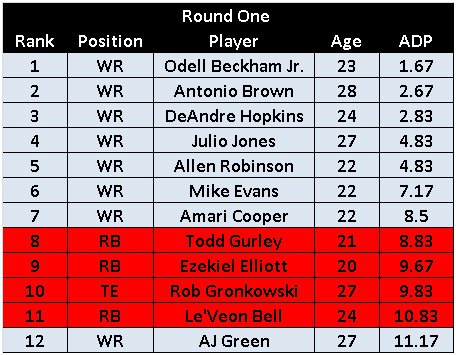
Round One Overview
There’s no way I’m going to draft a running back in the first round while implementing this strategy because the goal is to limit roster fragility and investing premium capital in a running back is the opposite of what we want to do. However, it’s still advantageous to draft Todd Gurley, Ezekiel Elliott or Le’Veon Bell if they fall into the second round of the draft. I’m not saying they’re not worthy of being a first-round startup pick but by selecting them you’re negating the premise of the strategy.
Age, injury history and price make it hard to go all in on Rob Gronkowski, especially when the main goal is to curtail instability within your roster. Even though he will give you a positional advantage, tight end is a position that you can fill later in the draft. I’m not totally against drafting him, but like the previously mentioned running backs, Gronkowski is worth selecting if he slides to a palatable price in the second round.
Snagging an elite wide receiver to anchor our rosters should be the goal in the first round, because our main focus is to draft a “murderer’s row” of wide receivers, passing on one of the top wide receivers would destroy the game plan.
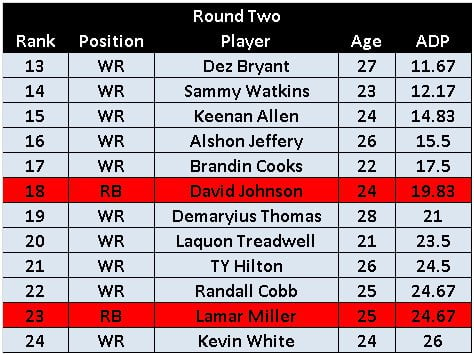
Round Two Overview
Just like the first round, we are still trying to snag as many premium wide receivers as possible. Some of these receivers can be targeted in the first round. Dez Bryant, Sammy Watkins, Keenan Allen, Alshon Jeffery and Brandon Cooks would be our prime targets in this round. A second-round pick is too valuable to burn on a running back while there are still a lot of talented wide receivers on the board. There’s to many talented wide receivers left to choose from to even think about drafting Lamar Miller or David Johnson.
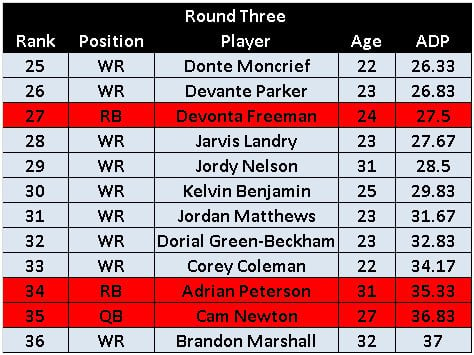
Round Three Overview
The third round is chalked full of talent at receiver and I would love to have any of them on my team. There’s no reason to draft Adrian Peterson and Devonta Freeman in the third round when there’s still a lot blue chip receiver prospects still on the board. I like Cam Newon, he’s one of my favorite quarterbacks, but for this strategy we want to draft quarterback late and continue to mine value at receiver.

Round Four Overview
The average dynasty owner who builds their teams around wide receivers are starting to focus on other positions during the fourth and fifth rounds, but too fully execute the strategy we must continue to stock our roster with quality wide receivers. Some of the receivers from the third round usually fall to the fourth round creating a plethora of high-end wide receivers to choose from making the fourth round one of the most crucial rounds of the draft. Many of the running backs in this round have question marks making it even harder to select them in this area of the draft.
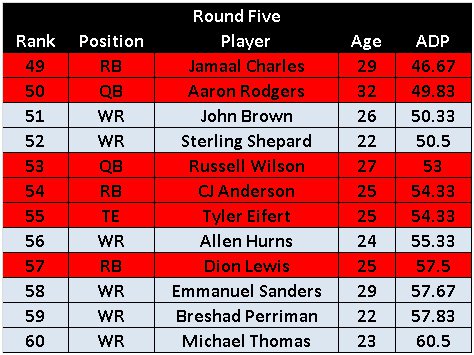
Round Five Overview
Like the previous four rounds, we are still fading QB, RB and TE and we are going to continue this process until the wide receiver well starts to run dry. Odds are low that Aaron Rodgers and Russell Wilson will end up on our rosters because they typically don’t slip much past their ADP. All the running backs in this range have question marks about their play or longevity, along with Tyler Eifert and his troublesome injury history. The logjam of wide receivers from the fourth round will start to seep into the fifth round, as some of the other owners in your draft will start to look at other positions, leaving value on the board at wide receiver.
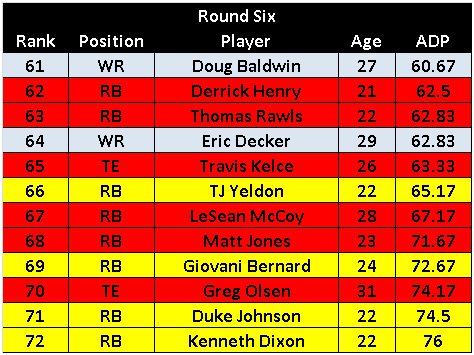
Round Six Overview
We are starting to get to the sweet part of the draft were there are less receivers to choose from and some of the young talented pass catching running backs are starting to emerge. Even though our roster is stacked with wide receiver talent, we are still granting tiebreakers to receivers when we make our draft selections. Some of the receivers from round five will fall to the sixth round and there are a couple wide receivers in the seventh round that you could reach on in the sixth round.
TJ Yeldon, Giovani Bernard, Duke Johnson and Kenneth Dixon are young talented pass catching running backs that usually fall to the middle to late rounds of a startup draft. These running backs fit the mold of what we are looking for, however there are plenty of talented wide receivers left on the board, making it easier to fade the running backs for a few more rounds. I have Derrick Henry and Thomas Rawls highlighted in red because they are more than likely not going to fall much farther than their ADP and it is better to stick with the program and continue to load up on receivers. Same deal with Travis Kelce, the plan is to draft tight end late, even though this a decent value for him, I’m still giving the nod to many of the wide receivers in this range.
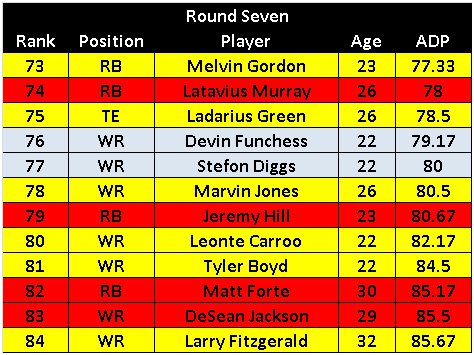
Round Seven Overview
The rubber is starting to hit the road as the quantity of premium wide receivers are decreasing by the round. Devin Funchess and Stefon Diggs are players that you can reach on in the mid- to late-sixth round. Ladarius Green is the first tight end that’s up for consideration due to his athletic prowess and being part of the Steelers’ high powered offense. Larry Fitzgerald is 32-years-old and due to his age he should only be selected if you feel like your team is going to be contender during the first year. DeSean Jackson is the first wide receiver to avoid because of his age and volatile production. Melvin Gordon is candidate to fall in some dynasty drafts past his current ADP, many dynasty owners forget that he was a premium prospect coming out of college and only remember what he did during his rookie season.
This might be one of the last rounds where you can snag one of the top wide receiver prospects, which could be the turning point in the draft where we could potentially decide to start drafting other positions. I would still lean wide receiver here if possible, keep in mind there are still values at receiver later in the draft.
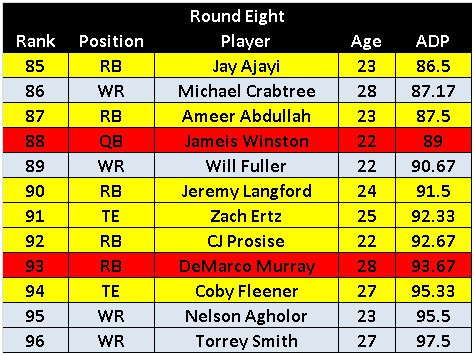
Round Eight Overview
We are going to see a few interesting wide receivers during this portion of the draft but it’s also time to consider other positions before it’s too late. Jeremy Langford, Ameer Abdullah, Jay Ajayi, and CJ Prosise all posses value in dynasty and could generate points in PPR leagues. Zach Ertz and Coby Fleener are both going to own a large market share of their team’s targets and their name cache is going to allow them to hold value for at least a couple more years. Due to his age and extensive injury history, We are going to avoid DeMarco Murray unless he falls in the draft. Nelson Agholor, Torrey Smith, Will Fuller and Michael Crabtree are the main wide receiver candidates in this round, but we should already have six to seven receivers by now, leaving us free to look at other positions. They are still players to target but there will be late round fliers later in the draft to consider at receiver to fill the back end of our roster.
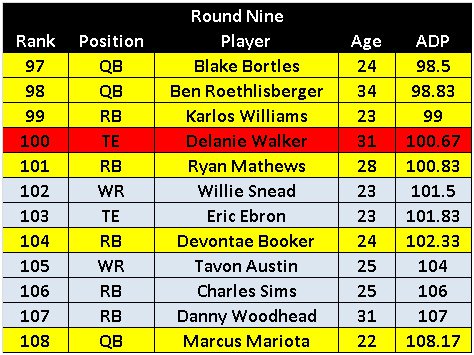
Round Nine Overview
The later we get in the draft the less we pay for the players we select, limiting the amount of risk we take on and making it easier for us to take shots at young upside running backs and wide receivers. Eric Ebron is one of my favorite players to scoop up in the middle rounds because he’s a high upside premium prospect who should get a lot of targets this season. Charles Sims and Danny Woodhead are the ultimate PPR backs and their usage in the passing game makes them the perfect fit in a roster that’s stacked with wide receiver talent. Blake Bortles, Ben Roethlisberger and Marcus Mariota are solid quarterbacks to own in dynasty but there are going to be more quarterbacks to choose from later in the draft, but I would pull the trigger on any of these quarterbacks if they fall into the tenth round or later.

Round Ten Overview
Jerick McKinnon and Tevin Coleman are high-end running back prospects who could become perennial starters if the lead back were to go down with an injury. Phillip Dorsett is the perfect wide receiver to have stashed at the end of your bench because he’s highly athletic and he’s in a prolific offense. Davante Adams is another one of my favorite end-of-bench stashes because there’s a good chance he’s still going to get another opportunity prove himself, which could make him the steal of the draft if he ever bounces back and produces solid fantasy number. Jonathan Stewart could be the perfect addition for a team that’s built to win-now.
It’s safe to say, with seven to eight wide receivers currently on the roster, we’re at a good point in the draft to focus on other positions, refraining us from holding the bag and missing out on talented prospects at other positions. With running back thinning out, it’s a good idea to target a few running backs before there’s a major drop off in talent.
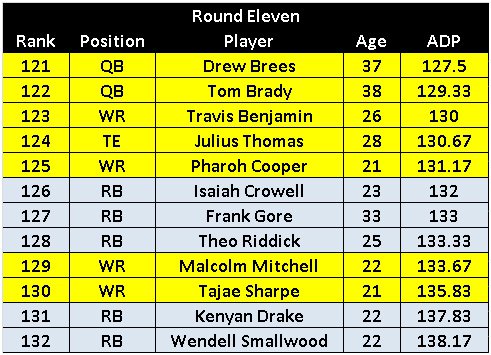
Round Eleven Overview
At this juncture in the draft we can afford to draft best player available and fill our roster according to need. By being paired with Andrew Luck in a high octane offense, Frank Gore could be a sneaky draft pick for a team built to win-now. Theo Riddick’s role in Detroit’s passing game will make him valuable in PPR leagues, making him a candidate to finish the season as an RB2 in fantasy. For a win-now team, Drew Brees and Tom Brady could deliver enough week to week points to help your team get over the hump and if your team is building for the future then Malcolm Mitchell, Tajae Sharpe, Pharoh Cooper and Kenyan Drake could be excellent additions to your roster.

Round Twelve Overview
The pattern of drafting late round quarterbacks, running backs and tight ends along with some young high upside wide receivers is starting to repeat itself. It’s necessary to monitor the flow of the draft going forward and select best player available while keeping roster construction in mind.
Jeff Janis is the ultimate end of bench stash for a loaded wide receiver corps and Kamar Aiken, who could be Baltimore’s number one receiver, is currently a great value when you consider his ADP. One thing to note, running back is starting to thin out, leaving less then desirable talent on the board.
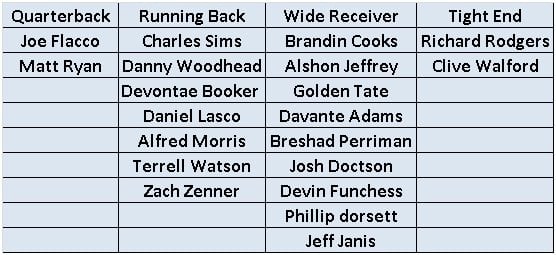
Here’s an example of how a roster could possible look like after executing the Zero RB strategy during a startup draft. As you would expect, the roster is stocked with young wide receivers with high upside. Running back appears to be weak, but has two fungible starters in Danny Woodhead and Charles Sims. Obviously, there’s not much depth at running back, making the upcoming rookie drafts, in season trades and the waiver wire crucial for success. This team has the potential to make the playoffs during the initial season but is built more for the long haul since the majority of the roster is filled with young prospects that are currently in the developmental stages of their career.
Honestly, there isn’t a perfect strategy to use for a startup draft because there are multiple different ways to build a dynasty team. Draft your team based off your preferences and skill sets and try not to over think things. If scouting rookies is one of your weak points, then drafting Zero RB during a startup might not be for you because rookie drafts are going to be very important when it comes to filling the running back position with talent. Trading is a skill, and dynasty owners that haven’t mastered the art might struggle getting the necessary deals done to optimize their lineup. Impatient owners will have the tendency to make irrational decisions because they won’t have the patience to watch their roster develop. Zero RB is a great strategy for active owners who are very studious, and have a good eye for talent. Dynasty is a game of skill that requires a lot of effort, the owners who put the most into their teams, usually come out on top.
[/am4show]
- 2024 NFL Draft: What We Expect for Day 1 - April 25, 2024
- Dynasty Fantasy Football Rookie Profile: Luke McCaffrey, WR Rice - April 19, 2024
- 2024 Dynasty Fantasy Football Rookie Profile: Will Shipley, RB Clemson - April 6, 2024


































































